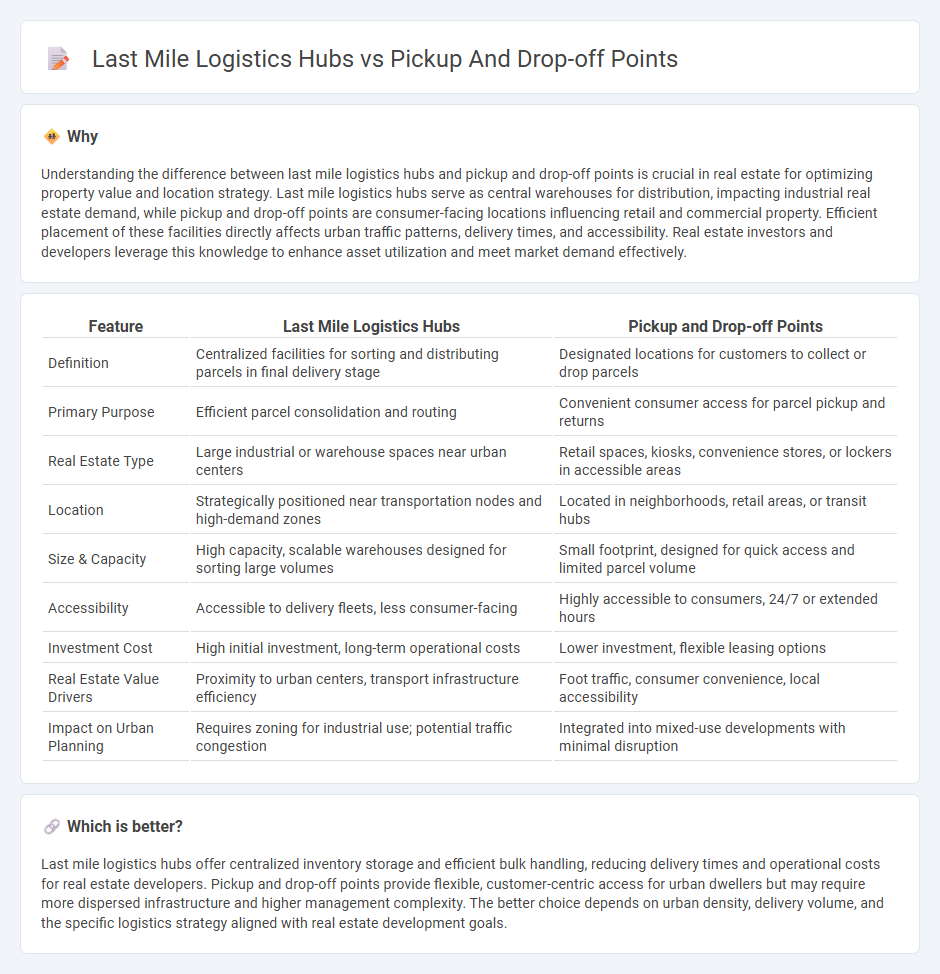
Last mile logistics hubs streamline real estate utilization by consolidating delivery operations within strategically located warehouses, enhancing efficiency and reducing urban congestion. Pickup and drop-off points occupy smaller spaces in high-traffic areas, offering convenience for consumers and supporting flexible delivery models. Explore how these real estate solutions transform urban logistics and consumer experiences.
Why it is important
Understanding the difference between last mile logistics hubs and pickup and drop-off points is crucial in real estate for optimizing property value and location strategy. Last mile logistics hubs serve as central warehouses for distribution, impacting industrial real estate demand, while pickup and drop-off points are consumer-facing locations influencing retail and commercial property. Efficient placement of these facilities directly affects urban traffic patterns, delivery times, and accessibility. Real estate investors and developers leverage this knowledge to enhance asset utilization and meet market demand effectively.
Comparison Table
| Feature | Last Mile Logistics Hubs | Pickup and Drop-off Points |
|---|---|---|
| Definition | Centralized facilities for sorting and distributing parcels in final delivery stage | Designated locations for customers to collect or drop parcels |
| Primary Purpose | Efficient parcel consolidation and routing | Convenient consumer access for parcel pickup and returns |
| Real Estate Type | Large industrial or warehouse spaces near urban centers | Retail spaces, kiosks, convenience stores, or lockers in accessible areas |
| Location | Strategically positioned near transportation nodes and high-demand zones | Located in neighborhoods, retail areas, or transit hubs |
| Size & Capacity | High capacity, scalable warehouses designed for sorting large volumes | Small footprint, designed for quick access and limited parcel volume |
| Accessibility | Accessible to delivery fleets, less consumer-facing | Highly accessible to consumers, 24/7 or extended hours |
| Investment Cost | High initial investment, long-term operational costs | Lower investment, flexible leasing options |
| Real Estate Value Drivers | Proximity to urban centers, transport infrastructure efficiency | Foot traffic, consumer convenience, local accessibility |
| Impact on Urban Planning | Requires zoning for industrial use; potential traffic congestion | Integrated into mixed-use developments with minimal disruption |
Which is better?
Last mile logistics hubs offer centralized inventory storage and efficient bulk handling, reducing delivery times and operational costs for real estate developers. Pickup and drop-off points provide flexible, customer-centric access for urban dwellers but may require more dispersed infrastructure and higher management complexity. The better choice depends on urban density, delivery volume, and the specific logistics strategy aligned with real estate development goals.
Connection
Last mile logistics hubs significantly enhance real estate value by optimizing delivery efficiency and reducing transportation costs for urban residential and commercial properties. Pickup and drop-off points integrated within these hubs facilitate seamless parcel handling, attracting tenant demand for properties with convenient access to logistics services. Proximity to these logistics nodes drives higher foot traffic and supports mixed-use developments, increasing overall property marketability.
Key Terms
Access Points
Pickup and drop-off points serve as convenient access points for customers to collect or return parcels, optimizing last mile delivery efficiency by reducing delivery times and costs. Last mile logistics hubs function as centralized nodes that facilitate sorting and redistribution of goods to these access points, enhancing supply chain fluidity and scalability. Explore more about how these access point strategies transform urban logistics and customer experience.
Final Delivery Nodes
Final delivery nodes include both pickup and drop-off points as well as last mile logistics hubs, serving crucial roles in the efficiency of supply chains. Pickup and drop-off points act as customer-facing locations enabling seamless parcel collection and return, whereas last mile logistics hubs function as centralized distribution centers streamlining transportation routes. Explore further to understand how optimizing these nodes enhances delivery speed and reduces operational costs.
Micro-fulfillment Centers
Micro-fulfillment centers serve as crucial last mile logistics hubs, optimizing inventory storage and enabling rapid order fulfillment near urban demand hotspots. Unlike conventional pickup and drop-off points that act primarily as access nodes for consumers, micro-fulfillment centers integrate advanced automation and real-time inventory management to reduce delivery times and costs. Explore the transformative role of micro-fulfillment centers in reshaping urban logistics and enhancing customer experience.
Source and External Links
UPS Access Point at CVS - Allows customers to pick up and drop off pre-packaged, pre-labeled UPS shipments at convenient locations like CVS stores.
FedEx Drop Off - Offers drop-off locations at FedEx Office, FedEx Ship Center, FedEx Authorized ShipCenter, FedEx Drop Box, Walgreens, Dollar General, and grocery stores.
Chicago O'Hare International Airport - Provides convenient curb-side drop-off and pick-up for passengers at all terminals.
 dowidth.com
dowidth.com